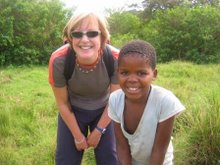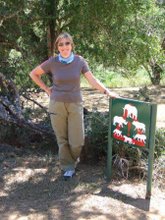We have been looking forward to Cape Town, having heard so many good things about it from all those ex-pat South Africans in Wellington. It didn't disappoint - we ended up spending a week here, wandering around the town (safely, for a change), the waterfront and further afield to Stellenbosch/Paarl/Franshoek wine areas, the Cape Peninsular and Robben Island. Oh yeah, and another walk, this time up Table Mountain.
Cape Town certainly is a fine city, beautifully located and with a great atmosphere. However, in spite of its reputation as a centre of racial tolerance, there was plenty of evidence to the contrary, notably in District Six (an inner city area from where the coloured and black population was forcibly removed, and their homes and workplaces demolished) and the vast Cape Flats - the euphemistically named "township". Every city or town of any size has a "township" where black people live, often in appalling conditions. These days of course they also live in the towns, if they can afford to, but the townships are exclusively black, and apparently crime and AIDS ridden. The AIDS rate for Sth Africa is around 40%, which is horrifying to think of. The government is slowly pulling its head out of the sand over the issue, but still prefers to downplay the situation. Not sure how long this attitude can last as eventually you would think the death rate must impact on the ANC's voting population. Speaking of the ANC, it was interesting to observe on Robben Island (the small offshore island which was prison to Nelson Mandela and other political prisoners for many years), the attempts to rewrite the history of "the struggle", downplaying and marginalising the role of the Pan African Congress - today, a political rival of the ANC, and always (it seems anyway) a more radical group. Our guide at Robben Island (robben is Dutch for "seal" - the English renamed it Penguin Island, but the Dutch name has proved the more enduring [kind of a metaphor for the country in some ways]), Michael, told us his incredible story. He joined a communist group as a young man and was trained in guerilla warfare in Mozambique and Angola, and then sent to East Germany for further training, before returning to Sth Africa and being promptly arrested and jailed for illegally leaving and re-entering the country. His story, and the fact of such widespread external involvement in "the struggle" made me realise that the story of apartheid is much more complicated than I had realised. I'm sure the Afrikaans population felt they were fighting a war; Michael certainly did. Still, it was incredible to think that the white population could forcibly continue to rule the country so brutally when they are outnumbered 10:1.
Cape Town certainly is a fine city, beautifully located and with a great atmosphere. However, in spite of its reputation as a centre of racial tolerance, there was plenty of evidence to the contrary, notably in District Six (an inner city area from where the coloured and black population was forcibly removed, and their homes and workplaces demolished) and the vast Cape Flats - the euphemistically named "township". Every city or town of any size has a "township" where black people live, often in appalling conditions. These days of course they also live in the towns, if they can afford to, but the townships are exclusively black, and apparently crime and AIDS ridden. The AIDS rate for Sth Africa is around 40%, which is horrifying to think of. The government is slowly pulling its head out of the sand over the issue, but still prefers to downplay the situation. Not sure how long this attitude can last as eventually you would think the death rate must impact on the ANC's voting population. Speaking of the ANC, it was interesting to observe on Robben Island (the small offshore island which was prison to Nelson Mandela and other political prisoners for many years), the attempts to rewrite the history of "the struggle", downplaying and marginalising the role of the Pan African Congress - today, a political rival of the ANC, and always (it seems anyway) a more radical group. Our guide at Robben Island (robben is Dutch for "seal" - the English renamed it Penguin Island, but the Dutch name has proved the more enduring [kind of a metaphor for the country in some ways]), Michael, told us his incredible story. He joined a communist group as a young man and was trained in guerilla warfare in Mozambique and Angola, and then sent to East Germany for further training, before returning to Sth Africa and being promptly arrested and jailed for illegally leaving and re-entering the country. His story, and the fact of such widespread external involvement in "the struggle" made me realise that the story of apartheid is much more complicated than I had realised. I'm sure the Afrikaans population felt they were fighting a war; Michael certainly did. Still, it was incredible to think that the white population could forcibly continue to rule the country so brutally when they are outnumbered 10:1.
Table Mountain looks spectacular seen from the deck of the boat on which we were ferried to Robben Island.
On a more cheerful note, we had two great outings - to the wine district where we happily sampled the very well-priced local product, and to the Cape which we visited on the day of a howling gale.
The nearly most southern tip of Africa, the Cape was as close as we got. Reminiscent of Wellington in a howling northerly.


No trip to the Cape is complete without a stop at Boulder Bay to admire the penguins. As always, very photogenic.
The climb up Table Mountain was a bit of a tough outing indeed, but relatively short, and we were rewarded with great views of the coast and the city (as you are if you take the comfortable and speedy cable car, which has a revolving floor so you get a 180 degree view on your trip). 

It´s a tough climb, but worth it.
This was our last night in Cape Town, and we celebrated by eating out at the Africa Cafe, a terribly touristy restaurant where you are fed a set menu of dishes from all over the continent and entertained by the staff drumming and singing (http://www.africacafe.co.za/).






No comments:
Post a Comment